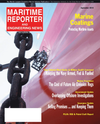
Page 45: of Maritime Reporter Magazine (September 2010)
Marine Propulsion Edition
Read this page in Pdf, Flash or Html5 edition of September 2010 Maritime Reporter Magazine
September 2010 www.marinelink.com 45
By Mark Evans, Applications Engineer,
Flow Technology, Inc.
Look around a marine vessel, and chances are you’ll find numerous flow measurement applications. These range from diesel fuel and hydraulic supply/re- turn lines, to generators, positioners and other onboard systems. Most flow-me- tering devices require periodic calibration in order to maintain their accuracy when subjected to the rigors of the vessel oper- ating environment. In many cases, how- ever, calibration of flowmeters on workboats, supply ships, fishing trawlers and ferries is simply overlooked. Cali- bration typically requires that meters be removed from the vessel and sent it to an outside lab for service. Depending upon the calibration provider, this process can take days (or weeks) to accomplish. In- creasingly, fleet operators are seeking a cost-effective way of performing calibra- tions to help maintain their flowmeters in optimal working order. The flow meas- urement industry has responded to this demand by offering portable Flow Trans- fer Standard (FTS) solutions that allow for easy and convenient meter calibra- tions.
Latest Portable Calibrators
Calibration equipment manufacturers have employed recent advancements in computer technology to develop FTS sys- tems that can be used as portable flowme- ter calibration/validation devices in a wide range of marine applications. Typi- cally offered in a suitcase kit, an FTS is regarded as a secondary standard with traceability, via a master flowmeter, to the National Institute of Standards and
Technology (NIST). Secondary standard calibrations are completed with a master flowmeter having been calibrated on a primary standard. The flow rate is derived from the master meter and other applica- tion inputs. Secondary standard calibra- tion uncertainty increases with the introduction of additional inputs to derive the flow rate and repeatability of the mas- ter meter. Designed to calibrate flowme- ters that cannot be easily removed from their application, an FTS is intended for in-line calibration of meters using the ac- tual measurement fluid. Some flow trans- fer standards also have the capability of measuring and correcting the influences of line pressure and temperature effects on flow.
How the System Works
Unlike older flow transfer standards in- tended for use with one flowmeter tech- nology only, today’s universal FTS design can calibrate or prove all princi- pal meter types. The calibrator employs an interface box that takes inputs from a master meter, temperature sensor, and pressure sensor and supplies these out- puts to the system software. Based on the inputs, the software can calculate the flow rate. The software merges the out- put information from the master meter, temperature sensor, pressure sensor and device-under-test, and generates a cali- bration data sheet in volumetric or mass units, which can be stored for future ref- erence.
With an FTS, overall system accuracy is dependent on several factors, including master flowmeter calibration, repeatabil- ity and primary standard accuracy; as well as temperature/pressure sensor ac- curacies. This fundamentally allows the user to tailor the accuracy of the system to meet their needs through the level of master sensors they choose to utilize. The key benefit of the FTS lies in its versatil- ity: the system can be installed into an ex- isting application utilizing the flow source and actual conditions of the meas- urement liquid.
In addition, a bypass system can be built into the application for ease of in- stalling the master meter with flow straighteners. Once the calibration is complete, the master flow meter can be replaced with a spool piece. This bypass approach maximizes accuracy while min- imizing costly downtime.
Benefits to vessel operators
Thanks to current flow transfer stan- dard technology, marine vessel operators can utilize a portable calibrator to moni- tor a critical operation or perform multi- ple calibrations to trend a flowmeter.
They can reduce calibration costs by only having to calibrate 3-5 master flowmeters to cover almost all the liquid flow appli- cations on a given vessel. Furthermore, this solution eliminates the need to rotate calibrated meters in order to ensure unin- terrupted operation. The use of an FTS also allows workboat fleets to implement regularly scheduled meter calibrations.
Vessel maintenance personnel can install the master flowmeter, calibrate the de- vice-under-test and print a calibration data sheet within just minutes.
This compares with the normal 2-3 week turnaround time necessary to re- move the flowmeter from the installation and send it out to a remote site for cali- bration service. In addition, portable FTS calibration solutions allow vessel opera- tors to schedule more frequent flowmeter calibrations. The calibration device can even serve as a tool for troubleshooting errors on meters. As a result, users can trend the actual meter in service to iden- tify operational issues or equipment mal- functions, as well as plot calibrations year over year in order to schedule any type of maintenance that might be re- quired.
Conclusion
Today’s advanced flow transfer stan- dards enable marine workboat fleets to perform accurate, fully documented flowmeter calibrations without the cost and complications associated with re- moving their instruments from service.
For a vessel operator with multiple flowmeters calibrated on an annual basis, the investment in an FTS system is typi- cally recouped within a year or less.
About the author
Mark Evans is an applications engineer for Flow Technology, Inc. (www.ftime- ters.com) in Tempe, Ariz. Email: [email protected].
TECHNICAL PUMPS, PIPES, VALVES
Flow Transfer Standards
Versatile Solution for Calibrating Vessel Flowmeters

 44
44

 46
46
